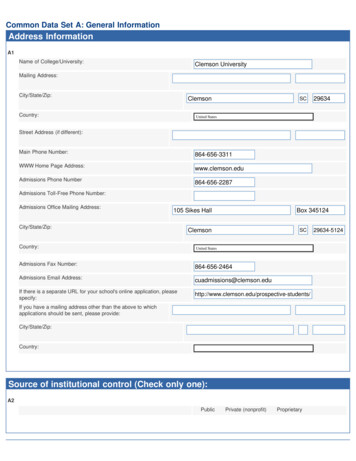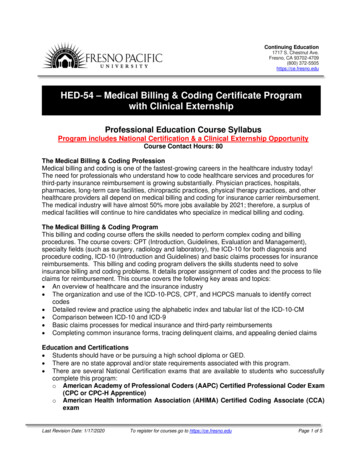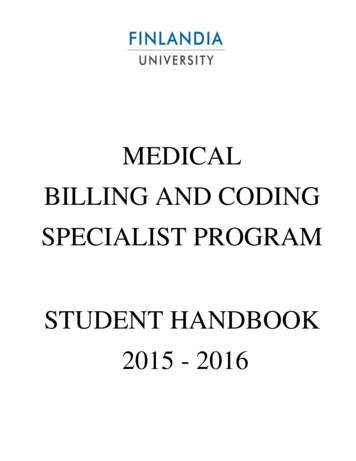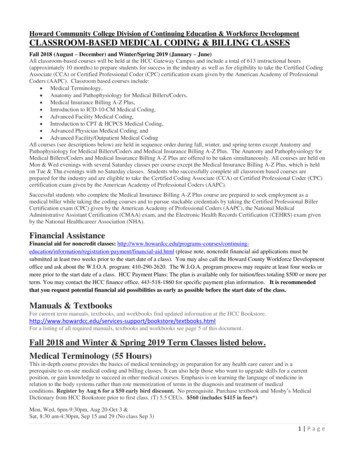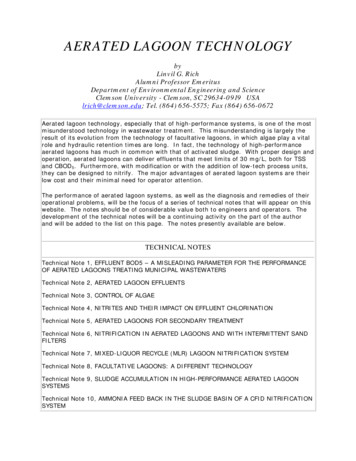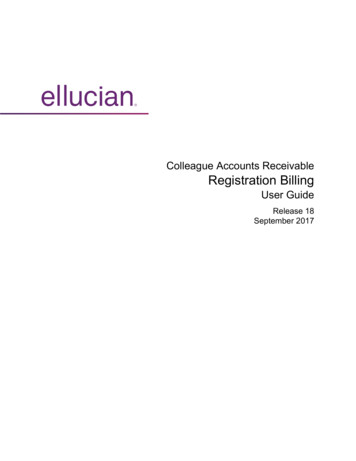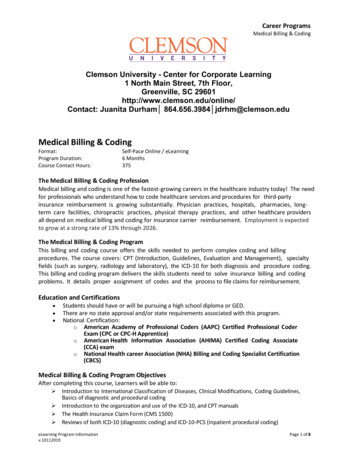
Transcription
Career ProgramsMedical Billing & CodingClemson University - Center for Corporate Learning1 North Main Street, 7th Floor,Greenville, SC 29601http://www.clemson.edu/online/Contact: Juanita Durham 864.656.3984 jdrhm@clemson.eduMedical Billing & CodingFormat:Program Duration:Course Contact Hours:Self-Pace Online / eLearning6 Months375The Medical Billing & Coding ProfessionMedical billing and coding is one of the fastest-growing careers in the healthcare industry today! The needfor professionals who understand how to code healthcare services and procedures for third-partyinsurance reimbursement is growing substantially. Physician practices, hospitals, pharmacies, longterm care facilities, chiropractic practices, physical therapy practices, and other healthcare providersall depend on medical billing and coding for insurance carrier reimbursement. Employment is expectedto grow at a strong rate of 13% through 2026.The Medical Billing & Coding ProgramThis billing and coding course offers the skills needed to perform complex coding and billingprocedures. The course covers: CPT (Introduction, Guidelines, Evaluation and Management), specialtyfields (such as surgery, radiology and laboratory), the ICD-10 for both diagnosis and procedure coding.This billing and coding program delivers the skills students need to solve insurance billing and codingproblems. It details proper assignment of codes and the process to file claims for reimbursement.Education and Certifications Students should have or will be pursuing a high school diploma or GED.There are no state approval and/or state requirements associated with this program.National Certification:o American Academy of Professional Coders (AAPC) Certified Professional CoderExam (CPC or CPC-H Apprentice)o American Health Information Association (AHIMA) Certified Coding Associate(CCA) examo National Health career Association (NHA) Billing and Coding Specialist Certification(CBCS)Medical Billing & Coding Program ObjectivesAfter completing this course, Learners will be able to: Introduction to International Classification of Diseases, Clinical Modifications, Coding Guidelines,Basics of diagnostic and procedural coding Introduction to the organization and use of the ICD-10, and CPT manuals The Health Insurance Claim Form (CMS 1500) Reviews of both ICD-10 (diagnostic coding) and ICD-10-PCS (inpatient procedural coding)eLearning Program Informationv.10112019Page 1 of 8
Career ProgramsMedical Billing & Coding Various issues surrounding the implementation of ICD-10HIPAA and Electronic Data Interchange (EDI)Review and practice coding Evaluation and Management (E&M) servicesReview and practice coding from anesthesia, surgery, radiology, medicine, and the pathology /laboratory sections of the CPT, CPT Modifiers, E and V CodesCoding surgical procedures of the integumentary systemCoding procedures related to the female genital system and maternity care and deliveryCoding for general surgery, radiology, pathology and laboratory servicesCoding for diagnostic and therapeutic services and the Level II National CodesTracing delinquent claims, insurance problems & third-party reimbursement issuesMedical Billing & Coding Program Detailed Student ObjectivesMedical TerminologyINTRODUCTION TO MEDICAL TERMINOLOGY Explain the role of medical terminology in the healthcare field List the types of medical terms Describe the word parts that make up a medical term Apply rules for combining word parts to create medical terms Use strategies to analyze medical termsANATOMICAL TERMINOLOGY Identify the planes and sections of the body Use correct directional terms to reference body position Use correct anatomical terms to reference body structures Align internal organs to the correct body cavityDERMATOLOGY: INTEGUMENTARY SYSTEM Define the medical specialty of dermatology Review basic anatomy of the integumentary system Identify common roots, combining forms, suffixes, and abbreviations related to the integumentary system Build medical terms related to the integumentary systemsORTHOPEDICS: MUSCULOSKELETAL SYSTEM Define the medical specialty of orthopedics Review basic anatomy of the musculoskeletal system Identify common roots, combining forms, suffixes, and abbreviations related to the musculoskeletal system Build medical terms related to the musculoskeletal systemsCARDIOLOGY: CARDIOVASCULAR SYSTEM Define the medical specialty of cardiology Review basic anatomy of the cardiovascular system Identify common roots, combining forms, suffixes, and abbreviations related to the cardiovascular system Build medical terms related to the cardiovascular systemHEMATOLOGY AND: IMMUNOLOGY: BLOOD AND IMMUNE SYSTEMS Define the medical specialties of hematology and immunology Review basic anatomy of the blood and immune systemseLearning Program Informationv.10112019Page 2 of 8
Career ProgramsMedical Billing & Coding Identify common roots, combining forms, suffixes, and abbreviations related to the blood and immunesystems Build medical terms related to the blood and immune systemsPULMONOLOGY: RESPIRATORY SYSTEM Define the medical specialty of pulmonology Review basic anatomy of lower respiratory system Identify common roots, combining forms, suffixes, and abbreviations related to the lower respiratorysystem Build medical terms related to the lower respiratory systemsGASTROENTEROLOGY: DIGESTIVE SYSTEM Define the medical specialty of gastroenterology Review basic anatomy of the digestive system Identify common roots, combining forms, suffixes, and abbreviations related to the digestive system Build medical terms related to the digestive systemUROLOGY AND NEPHROLOGY: URINARY SYSTEM AND MALE REPRODUCTIVE SYSTEMS Review basic anatomy of the urinary and male reproductive systems Identify common roots, combining forms, suffixes, and abbreviations related to the urinary and malereproductive systems Build medical terms related to the urinary and male reproductive systems Define the medical specialty of neurologyOBSTETRICS AND GYNECOLOGY: FEMALE REPRODUCTIVE SYSTEM Define the medical specialties of obstetrics and gynecology Review basic anatomy of the female reproductive system Examine the processes of fertilization, pregnancy, labor, and delivery Identify common roots, combining forms, suffixes, and abbreviations related to the female reproductivesystem, pregnancy, and childbirth Build medical terms related to the female reproductive system, pregnancy, and childbirthNEUROLOGY: NERVOUS SYSTEM Define the medical specialty of neurology Review basic anatomy of the brain, spinal cord and nerves Identify common roots, combining forms, suffixes, and abbreviations related to the nervous system Build medical terms related to the nervous systemENDOCRINOLOGY: ENDOCRINE SYSTEM Define the medical specialty of endocrinology Review basic anatomy of the glands of the endocrine system Identify common roots, combining forms, suffixes, and abbreviations related to the endocrine system Build medical terms related to the endocrine systemOPHTHALMOLOGY AND OTORHINOLARYNGOLOGY: THE EYE, EAR, NOSE, AND THROAT Define the medical specialties of ophthalmology and otorhinolaryngology Review basic anatomy of the eye, ear, nose, and throat Identify common roots, combining forms, suffixes, and abbreviations related to the eye, ear, nose, andthroateLearning Program Informationv.10112019Page 3 of 8
Career Programs Build medical terms related to the eye, ear, nose, and throatMedical Billing & CodingMedical Billing & CodingREIMBURSEMENT, HIPAA, AND COMPLIANCE Address ethical issues related to medical coding Describe the purpose and components of Medicare Parts A, B, C, and D Explain the role of Quality Improvement Organizations (QIOs) Identify goals of the Health Insurance Portability and Accountability Act (HIPAA) Explain the relevance of the Federal Register for physician reimbursement Explain the third-party reimbursement structure established by the Resource-Based Relative ValueScale (RBRVS) system Describe the structure of Medicare fraud and abuse prevention Identify the major components of Managed Health CareICD-10-CM GUIDELIES: AN OVERVIEW Identify the first-listed diagnosis in an encounter or visit Describe the coding guidelines for unconfirmed diagnoses Describe the coding guidelines for outpatient surgery Describe the coding guidelines for additional diagnoses Explain Z code reporting Distinguish between first-listed conditions and coexisting conditions Describe the reporting of an observation stay Describe the reporting of an uncertain diagnosis Describe the coding guidelines for chronic diseases Describe the coding guidelines for diagnostic services Distinguish between ICD-9-CM coding and ICD-10-CM coding Discuss the challenges and benefits of the ICD-10-CM coding systemICD-10-CM: ORGANIZATION AND RULES Use the Alphabetic Index and Tabular List Explain the steps to accurate coding Explain the organization of the Official Guidelines for Coding and Reporting Explain the need for level of specificity in diagnosis coding Explain how to assign multiple codes to a single condition Differentiate between the reporting of acute and chronic conditions Explain how to apply combination codes Differentiate between residual and late effects Describe the coding guidelines for chronic diseases Describe how to determine if a condition is impending or threatenedeLearning Program Informationv.10112019Page 4 of 8
Career Programs Explain the rules for reporting the same diagnosis code more than once Explain how to assign codes based on lateralityMedical Billing & CodingICD-10-CM: CODING GUIDELINES PART 1 Analyze codes for infectious and parasitic diseases Analyze codes for neoplasms Analyze codes for the blood and blood-forming organs Analyze codes for disorders involving the immune mechanism Analyze codes for endocrine, nutritional, and metabolic diseases Analyze codes for mental, behavioral, and neurodevelopmental disorders Analyze codes for disease of the nervous system Analyze codes for diseases of the eye and adnexa Analyze codes for conditions of the ear and mastoid processICD-10-CM: CODING GUIDELINES PART 2 Analyze codes for diseases of the circulatory system Analyze codes for diseases of the respiratory system Analyze codes for diseases of the digestive system Analyze codes for diseases of the integumentary system Analyze codes for diseases of the musculoskeletal system Analyze codes for the genitourinary systemICD-10-CM: CODING GUIDELINES PART 3 Analyze codes for conditions related to pregnancy, childbirth, puerperium, and the perinatal period Analyze codes for congenital malformations, deformities, and chromosomal abnormalities Explain how to code symptoms, signs, and abnormal clinical laboratory findings that are not elsewhereclassified Explain how to code injury, poisonings, and certain other consequences of external causesINTRODUCTION TO CPT LEVEL II NATIONAL CODES (HCPCS) Differentiate between CPT and HCPCS coding systems Explain the three categories of CPT codes Identify main terms and subterms in procedure documentation Use the CPT manual to locate and verify codes for services and procedures Explain the handling of unlisted procedures/services and the special report Apply HCPCS codesCPT MODIFIERS Explain the purpose of CPT modifiers Assign CPT modifiers to various service and procedure scenariosCPT CODING: EVALUATION AND MANAGEMENT (E/M) SERVICES Explain the three components of E/M code assignment Analyze documentation of patient history, examination, and medical decision-making according to thelevel of service, and then use your knowledge to select the correct codes Assess contributing factors as they apply to the level of service and code selection Apply CMS Documentation Guidelines to assign codes to E/M servicesCPT CODING: ANESTHESIA Differentiate between types of anesthesia Use the anesthesia formula to calculate paymentseLearning Program Informationv.10112019Page 5 of 8
Career Programs Appropriately code anesthesia services Assign modifiers to anesthesia codesMedical Billing & CodingCPT CODING: SURGERY Review guidelines and notes in the Surgery section Explain the requirements for using unlisted procedure codes Use the separate procedure designations correctly Describe the contents of a surgical packageCPT CODING: INTEGUMENTARY SYSTEM AND MUSCULOSKELETAL SYSTEM PROCEDURES Review procedure types specific to the integumentary system Calculate lesion size Apply lesion size calculations to coding Apply guidelines and notes to code integumentary system procedures across anatomical sites Correctly apply modifiers relevant to integumentary system codes Use add-on codes relevant to integumentary system codes Review procedure types specific to the musculoskeletal system Differentiate between fracture treatment types Apply guidelines and notes to code musculoskeletal system procedures across anatomic sitesCPT CODING: RESPIRATORY SYSTEM Apply anatomical information and respiratory terminology to locate correct codes Differentiate among codes based on the surgical approach used for the procedure Apply rules to correctly code respiratory services and proceduresCPT CODING: CARDIOVASCULAR SYSTEM PROCEDURES Organize cardiovascular services according to the Surgery, Medicine, and Radiology specialties Differentiate among the rules for coding across the three CPT sections Apply guidelines and rules to correctly report cardiovascular services Apply anatomical information and cardiovascular terminology to locate correct codesCPT CODING: HEMIC, LYMPHATIC, MEDIASTINUM, AND DIAPHRAGM PROCEDURES Assign codes to the hemic and lymphatic systems services Assign codes to mediastinum and diaphragm services Identify procedures relating to the spleen and corresponding systemsCPT CODING: DIGESTIVE SYSTEM PROCEDURES Review the format and codes of the Digestive System subsection Identify the anatomy and terminology of the digestive system sites and organs Apply guidelines and rules to correctly code procedures within the Digestive System subsectionCPT CODING: URINARY AND MALE REPRODUCTIVE SYSTEM PROCEDURES Align procedures to anatomical structures within the urinary and male genital system subsections Apply rules and guidelines to correctly assign codes to urinary system procedures Apply rules and guidelines to correctly assign codes to male genital system procedures Align procedures to anatomical structures in the male genital system subsectionCPT CODING: FEMALE REPRODUCTIVE SYSTEM, MATERNITY CARE AND DELIVERY PROCEDURES Apply guidelines and rules to correctly code reproductive and intersex surgery services Apply guidelines and rules to correctly code female genital system procedureseLearning Program Informationv.10112019Page 6 of 8
Career ProgramsMedical Billing & Coding Apply guidelines and rules to correctly code maternity care and delivery proceduresAlign procedures to anatomical structures in the female genital system subsectionDefine services in the global maternity and delivery packagesAlign procedures to the period performed, from ante- to postpartum, for maternity and delivery care.CPT CODING: ENDOCRINE AND NERVOUS SYSTEM PROCEDURES Align procedures to the glands of the Endocrine System Apply guidelines and rules to correctly code the endocrine system services Align procedures to the Nervous System subsections Apply guidelines and rules to correctly code the nervous system servicesCPT CODING: EYE AND OCULAR ADNEXA, AUDITORY SYSTEM, AND MICROSCOPE PROCEDURES Code eye and ocular adnexa services Code auditory system services Report the use of an operating microscopeCPT CODING: RADIOLOGY PROCEDURES Align radiology terminology to appropriate procedures Describe component coding in the reporting of radiology services Apply rules and guidelines to correctly code radiology services and proceduresCPT CODING: PATHOLOGY AND LABORATORY PROCEDURES Align pathology and laboratory terminology with CPT subheadings for related services Describe the use of venipuncture with pathology and laboratory services Define a facility indicator Apply guidelines to correctly code pathology and laboratory servicesCPT CODING: MEDICINE PROCEDURES Align procedures to the correct subsection and category Correctly code immunization administration and products Correctly code procedures from the Medicine section of the CPTINPATIENT CODING Differentiate between inpatient and outpatient coding Define the principal diagnosis and procedure Determine when a condition should be reported as an additional diagnosis Explain the purpose of the present on admission indicators Explain the purpose and use of the ICD-10-PCS system Apply the guidelines for selection of a principal diagnosis to sequencing procedure codes Use the official guidelines for coding and reporting to determine when a condition should be reportedas an additional diagnosiseLearning Program Informationv.10112019Page 7 of 8
Career ProgramsMedical Billing & CodingeLearning Program Informationv.10112019Page 8 of 8
Medical Billing & Coding. eLearning Program Information Page 4 of . 8. v.10112019 Build medical terms related to the eye, ear, nose, and throat . Medical Billing & Coding . REIMBURSEMENT, HIPAA, AND COMPLIANCE Address ethical issues related to medical coding Describe the purpose and components of Medicare Parts A, B, C, and D
